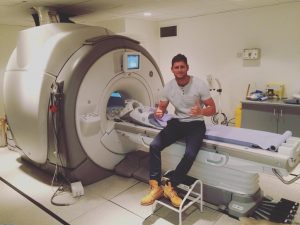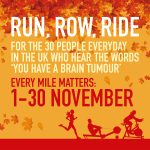Here long time brainstrust supporter and ambassador Barty Hills shares a frank and stunning insight into the challenges that come following treatment for a brain tumour.
So much of what Barty has to say resonates with what we’re hearing from hundreds of others. There’s a massive gap between this dogged determination to improve clinical care and the quest for a cure, it’s so frustrating. Even more so for those who are “cured”. There’s so much to rationalise: ‘why me?’, ‘why now?’, ‘where do I pick up?’, ‘what does the future look like?’, ‘why do people keep saying I’m lucky?’.
For Barty to share this reality so boldly is vital in helping others understand what life with a brain tumour, and the new normal it brings, is like.
Post brain-tumour update, 13 March 2019:

“It’s taken me a bit of time to realize that having 2 brain tumour surgeries was actually pretty easy. Not trying to sound like a tough guy, I mean you’re on so many drugs you can’t feel anything anyway, but keep reading…
(I just want to say that this is my experience with my brain tumour, which apparently was a good one to have, and not to take anything from those who have much harder battles to fight).
I used the word easy in the context with and comparison to the mental challenges we can all face for a million different reasons. My mental struggle could have come as a repercussion from the surgery or any number of reasons but the reason is not important.
Surgery was easy because I had fantastic support from my family and friends. I was made to feel like a war hero when all I was doing was surrendering myself to the impressive capabilities of neurosurgeons, whilst being put to sleep for a few hours. I may be downplaying it a bit, there is some acceptance that you have to come to terms with, but generally I was happy getting so much attention for a nap.
The aftermath
But it is really the aftermath, the normal life without support – and expectancy to crack on and live a normal/successful life – that’s the difficult part. Expectancy is a dangerous thing. I became used to being taken care of and everyone always asking how I was and telling I was doing very well etc.

Don’t get me wrong – this is amazing and has shown me the greatest side to people. I’m saying it was easy enough to live under the identity of a brain tumour survivor, and nothing more. We are all so much more than the little identities we box ourselves in. Honestly, being brain tumour free “normal” has been the hardest battle I’ve had to fight.
You’re alone and trying to figure things out by yourself and it’s a crazy ever changing monstrous world out there that doesn’t care about you. You have to care about you and figure out how to live and be happy by yourself.
But now 3 years after my last surgery and still brain tumour free I feel like I am getting better. Not because of my physical health, job or anything else, but because I am finally accepting myself as I am and choosing to prioritise my mental well-being and work on me, for me.
Learning to enjoy the ride

It’s very tough and I will always be a work in progress with ups and downs, highs and lows. Destination in sight but no finish line, just learn to enjoy the ride. I am just getting started, feeling a bit like Bambi on skates, but happy to be here where I am now and knowing that I’m going to give it everything I’ve got to become the best version of Barty!
Thank you to everyone who’s been part of my journey so far, I really appreciate all of you.
Shout out to everyone going through their mental battles everyday. Keep working on you and focus on what makes you happy! Accept and appreciate who you are now and be excited for where you are going!
And for any brain tumour sufferers out there, I’m always here if you wanna chat.”
You can follow Barty on Twitter @BartyHills
This Brain Tumour Awareness Month – share your story. Drop an email to eve@brainstrust.org.uk if you’d like to share your story, to help other people understand the impact of a brain tumour diagnosis.









